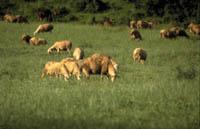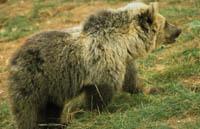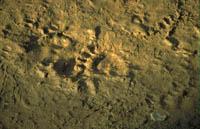Camille: more than the last bear of Euskal Herria
The survival of these magnificent mammals has become very difficult in the Pyrenees and the bear known as Camille could be the last of this species in our territory. But being an animal in serious danger of extinction...
... why do you want to catch Camille?

1998 was a tough year in the Roncal Valley. The hardest of the last years. Once settled in this valley, Camille constantly attacked her flocks, provoking a strong opposition to the bear among the shepherds. It was not enough the damages that the government dedicated to the pastors to reassure them. The ranchers did not admit bears around them and made it clear that for them the best solution was to kill.
Those responsible for the Department of the Environment of Navarre and the forest rangers suffered terrible headaches with the apparitions of Camille and, in search of a solution, they would try to catch the bear and, in that case, were promised to the shepherds who were going to place a collado with transmitters. This special collate would issue a continuous signal and technicians at all times would have knowledge of the bear. Knowing where it was, it did not seem so difficult to take care of the herds that were circulating in the area and avoid attacks. However, Camille has shown a great ability to escape all the traps that have been put by the technicians and by the time they have not been able to catch them.
Why does Camille attack?
Camille is a brown bear that despite the fact that three quarters of its food consists of foods of vegetable origin, they also need animal foods. According to studies carried out by experts, cattle represent between 6-8% of the diet of the Pyrenean bear. In any case, with the 200 banned sheep, Camille beat all records in 1998. Why so many aggressions?
It is a question of difficult answer and probably has no single answer. However, there are points to clarify. Since our ancestors learned to graze, basapiztis suffered herd attacks and although the relationship between human beings was conflictive, man learned to take (and anticipate the attacks of wolves). In this way, the shepherds walked by the sheep by the mountain and used shepherds or dogs of mastiff breed to fight the great carnivores. The adoption of these measures made it difficult to attack these beasts.

However, in recent years, and with the decline of bears and wolves, the use of animals has changed radically. The shepherds are no longer completely with the cattle and are hardly placed. In some cases, in addition, sheep herds can remain on the mountain without being seen by anyone, and the bear can do whatever it wants then. Guilt of the shepherds? In this harsh situation, we must not seek guilty. As in most places where large carnivores disappear, in Roncal the handling of the cattle has changed radically and the bear has too much facility to act as they wanted. However, at the same time as street workers demand a 35-hour workweek, we have no right to ask pastors for a 24-hour daily job to prevent bear attacks. Therefore, any solution to the problem must take into account the office and way of life of pastors and understand their thinking. And, without the recognition of the rural population, all attempts to preserve the bear will be useless.
How many bears do we have in the Pyrenees?
The bear has suffered a huge decline in most European countries and only a few are the regions that have maintained the bears. One of them is the Pyrenean mountain range, in which only six specimens remain: The prestigious Camille that runs around Roncal, Oza, Aspe and Lescun, and five others in the Ossau valley. Apparently, with the interposed Somport road, Camille does not pass to Ossau, so it has no relation to its bears.
Moreover, within the planning for the recovery of the bear, in 1996 and 1997 three bears from Slovenia were released in the French Central Pyrenees. Thus, at present, two of the Slovenian bears, plus four created by them, inhabit another 6 bears in the mountains of the region of Melles (Garona Garaia).
What is the future of Camille?
Unfortunately, the future of our last brown bear is very black. Camille is a 20-year-old "boyfriend" who, in addition to being a female, will hardly be able to find her on the side of Ossau while no one approaches her. The Pyrenees, are not like before. The continuous alteration of the environment by humans makes roads, tracks, tourists, mountaineers, etc. impose excessive pressure on these mountains. Thus, sensitive animals like bears must be hidden in the last "sanctuaries", but less and less corners can offer them peace and quality. Therefore, if unexpected miracles do not occur and other measures are not adopted, it must be said that the pyrenean bears will disappear.

A way to avoid it can be the strengthening of the local population with specimens coming from abroad. That is, something similar to what they did in the Central Pyrenees. However, returning to the question of Roncal, when with the only specimen we still have, we have this type of incident and we do not reach agreement with those affected, the introduction of external specimens does not make much sense. In addition, the most serious problems, such as habitat loss in the Pyrenees and illegal hunting, are maintained and, therefore, even with the release of bears, it will be difficult to achieve sustainable populations.
But… does it matter that Camille or the rest of Pyrenean bears disappear?
The last six numbers are scarce. Although in most places people want the bears to live, the shepherds of Izaba or Garde, who are witnesses of the last bears, do not want it. His life is much quieter without bears: not having to take care of the sheep at night, less headaches... In addition, in the world there are thousands of brown bears and the species in general is not in danger of extinction. Is it, therefore, worth making an effort to care for bears where there are so few specimens?
Sure! The bear is a kind of great importance. The best exponent of the good state of health of the environment, the emblematic animal, protagonist of wonderful legends, the human ancestor, according to the ancient suletines, is one of the greatest patrimonies of our fauna. Therefore, and certainly, we should try to protect ourselves, since the Pyrenees without bears, the Pyrenees without Kings of the Mountains, will never be what they were. Therefore, Camille is an animal of great importance. If lost, much more will be lost than the last bear of Euskal Herria. And it is that the possession of the bears in our territory, would indicate that the balance between development and conservation of the medium is possible. For our part, we wish Camille the best fortune, because he will need it...
Published in 7
Buletina
Bidali zure helbide elektronikoa eta jaso asteroko buletina zure sarrera-ontzian











